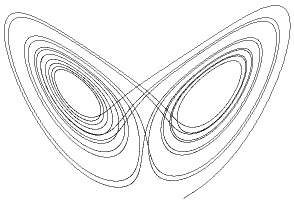 |
Interaction Theory: Nonlinearity, Critical Curriculum Theory, Self-Adaptive Complex Systems, & Educational Practice |
 |
 |
Interaction Theory: Nonlinearity, Critical Curriculum Theory, Self-Adaptive Complex Systems, & Educational Practice |
 |
What does it mean to thrive in an increasingly nonlinear 21st century world? What does linear and nonlinear mean? The answer to the first question depends in part on a much better understanding of the answer to the second. Far more people are experienced and comfortable with linear thinking than nonlinear. In different kinds of mechanical, living and social systems, two items bump together and they are either changed or unchanged by the interaction. These items might be things, organisms and people and their ideas. Interaction and the results of the interaction of two or more elements would seem to be a rather simple idea. If the degree and nature of the change can be predicted, linear solutions can be developed that will continue to solve the problem and many of its variations. If a system is nonlinear, then starting from the same initial conditions one set of interactions will diverge from the second, and in many nonlinear systems, they diverge exponentially with time, making long term prediction impossible. If a social system requires increasing levels of creativity, inventiveness and entrepreneurship, to what degree should linear, predictable thinking be taught, promoted and demonstrated?
All life and its complexity are a direct result of the outcomes of varying degrees of interaction between different types of things, organisms and ideas. The very effectiveness of education is dependent on the frequency and the depth of interaction between the learner and the content. So, just how interesting and complex can interaction become?
In fact, the study of interaction and nonlinearity can lead to some rather deep ideas about many questions. To what degree can science and its claims for the power of theorizing, discovery and prediction be applied to education? Is there an underlying conceptual basis for dramatic revision of classroom practice? Is such a suggestion really necessary? Can such an idea be supported by a coherent educational philosophy? This discussion and its linked documents addresses these questions through review of the work on nonlinear dynamics and its relationship to critical curriculum theory, educational theory and educational practice. It includes an in-depth treatment of the topic and links to both the scientific and philosophical thinking that have grown with this understanding. It concludes with a jump from conceptual and philosophical ideas into the delivery of practical implications for everyday life, classrooms and culture.
Once the effectiveness of the scientific system is accepted for teasing out and discovering degrees of linear, predictable and thereby controllable results, it becomes difficult to accept that science has its own boundaries beyond which other ways of thinking must be used. Perceptions about system behavior and our ability to control it can carry into our mental and social worlds. This could be a fundamental reason that the primary result of longitudinal educational research is NSD (No Significant Difference). The average of those who can do something and those who cannot in a classroom (including learners and teachers) can make the impact of talented innovation appear either irrelevant or not useful. This can blunt the incentive to sharpen human talent and to hunt for the unique evolving capacities of those who teach. This blunting is a result of believing in the myth of predictability and the all powerful value of more linear statistics, that prescriptions and scripts in nonlinear systems can yield long term predictable results.
The mathematical definition of a chaotic system is one that diverges exponentially with time. Science has demonstrated unequivocally that there is a bounded divergence in the physical world. For example, if the temperature rises too high or too low, life forms die; in between there is marvelous chaotic diversity that self-organizes into systems of limited duration. There is predictability but with severe limits, limits that become more severe for those systems of greater importance to human life. What gives us confidence in our educational theory and its supporting methodology and practices? How does education improve itself? Can government policy and funding be based on scientifically proven educational innovations? What can be counted on to be useful in tomorrow morning's classrooms?
To better understand nonlinearity, it is helpful to study better known nonlinear systems. When the first gentle puffs of moisture begin to rise from the yard's morning dew as well as the shoreline's ocean waves, there is little about the behavior of the weather system that would indicate that its growing intensity could yield a storm, tornado or hurricane. An organized system with predictable properties does not exist. Yet the growing flow of highly interactive energy can have its patterns diverge unpredictably, sometimes quite suddenly. At the top of this page, the butterfly of biology on the left and the statistical graph model of nonlinear behavior on the right that bears some resemblance to a real butterfly have become iconic symbols of the extreme sensitivity to initial conditions by interactive systems. Nonlinear science provides hard evidence of the consistent similarities in the nonlinear nature of interactive systems at every level in every field of study. Mathematics has made it clear that it is not about the number of variables, but about the nature of interaction among elements that are open to change, whether its 2 or 3 variables or 2 or 3 thousand. In many nonlinear systems, inconsistencies cannot be averaged out to long term predictable and usable results no matter how much data is collected.
Leamer applies this concept in the context of economics:
"You may want to substitute the more familiar scientific words “theory and evidence” for “patterns and stories.” Do not do that. With the phrase “theory and evidence” come hidden stow-away after-the-fact myths about how we learn and how much we can learn. The words “theory and evidence” suggest an incessant march toward a level of scientific certitude that cannot be attained in the study of the complex self-organizing human system that we call the economy. The words “patterns and stories” much more accurately convey our level of knowledge, now, and in the future as well. It is literature, not science" (Leamer, 2009, p.3).
That is, there are solveable and non-solvable problems. There are also problems for which there is a time limit in which predictions will hold, e.g., the weather and the economy, problems for which it is a waste of effort to count on usable long term predictions. If this is so true for weather and the economy whose basic physics and social mechanics are well understodd and for which there are overwhelming quantities of current and longitudinal data, then how much more true for the more strongly nonlinear systems called learners, teachers and educational systems for which we will always have much less data or understanding.
 One early nonlinear understanding about the self-organizing nature of competition and cooperation between the many flows of energy, whether the physics of water or connections of neurons, is deeply embedded in human history. The ancient yin-yang symbol was an expression of both predictability and sudden surprising change. In the flush of every waxing phenomena were the seeds of its reversal or transformation. The astonishing aspect to life is its capacity under such uncertainty to not merely survive but to thrive. To thrive is not just about knowing what can be predicted, but learning methods for the constant application of creative problem-solving intelligence to a constantly changing world.
One early nonlinear understanding about the self-organizing nature of competition and cooperation between the many flows of energy, whether the physics of water or connections of neurons, is deeply embedded in human history. The ancient yin-yang symbol was an expression of both predictability and sudden surprising change. In the flush of every waxing phenomena were the seeds of its reversal or transformation. The astonishing aspect to life is its capacity under such uncertainty to not merely survive but to thrive. To thrive is not just about knowing what can be predicted, but learning methods for the constant application of creative problem-solving intelligence to a constantly changing world.
Currently, science has discovered a wide range of nonlinear models with intriguing structures and unpredictable outcomes. Those images and related ideas appear in a much more significant treatment of this topic which is titled A Critical Analysis of Educational Theory, which provides an in-depth study linking scientific discoveries in nonlinear dynamics and educational philosophy with the challenges of curriculum development and educational planning.